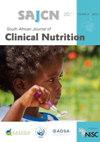不同食物组对南非西北省低社会经济社区6- 9月龄婴儿膳食摄入的能量和营养贡献
IF 0.6
Q4 NUTRITION & DIETETICS
引用次数: 0
摘要
目的:研究不同食物组对6 ~ 9月龄婴儿膳食摄入的能量和营养贡献。设计:使用初步随机对照试验的基线数据进行了一项观察性研究,旨在确定鸡蛋摄入对婴儿生长的影响。环境和对象:参与者居住在南非西北省的一个城市周边社区(Jouberton)。该研究包括6至9个月以下的婴儿(n = 155);24小时饮食回忆数据为n = 144。结果:大多数婴儿食用八组食物中的两组(29.2%)或三组(42.4%)。95.8%的婴儿食用谷物/根/块茎组;对于消费者来说,它提供了75.5%的铁,53.0%的硫胺素和42.5%的叶酸。64.4%的婴儿分别食用母乳和奶制品。对于母乳喂养的婴儿,母乳是能量和脂肪以及一些微量营养素(钙、锌、维生素A、维生素C、烟酸和核黄素)的主要来源;但与非母乳喂养的婴儿相比,除维生素A外,所有微量营养素的摄入量都较低(p < 0.05)。对于动物源食品(ASFs)的消费者(16.7%),这些食品提供42.8%的维生素B12和33.4%的蛋白质;蛋白质、核黄素和维生素B12的摄入量均高于非消费者(p < 0.05)。食用最少的食物是豆类(0.7%)、肉类(6.9%)和鸡蛋(10.4%)。结论:谷物/根/块茎、乳制品和母乳对关键营养素的摄入贡献最大。动物源性食品的消费并不频繁,但对消费者来说,它们也做出了重大贡献。建议:改善饮食多样性的战略应鼓励继续母乳喂养,旨在增加不经常食用的食物类别的摄入量,并促进当地可获得的食物。本文章由计算机程序翻译,如有差异,请以英文原文为准。
Energy and nutrient contribution of different food groups to the dietary intake of 6- to <9-month-old infants in a low socioeconomic community in North West Province, South Africa
Objective: A study was undertaken to determine the energy and nutrient contribution of different food groups to the dietary intake of 6- to <9-month-old infants. Design: An observational study was conducted using baseline data of a preliminary randomised controlled trial that aimed to determine the effect of egg consumption on infant growth. Setting and subjects: Participants resided in a peri-urban community (Jouberton) in North West province, South Africa. The study included 6- to <9-month-old infants (n = 155); 24-hour dietary recall data were available for n = 144. Results: Most infants consumed either two (29.2%) or three (42.4%) out of eight food groups. The grains/roots/tubers group was consumed by 95.8% of infants; for consumers thereof, it contributed 75.5% of iron, 53.0% of thiamine and 42.5% of folate. Breast milk and dairy were consumed respectively by 64.4% of infants. For breastfed infants, breast milk was the major contributor of energy and fat, and some micronutrients (calcium, zinc, vitamin A, vitamin C, niacin and riboflavin); but they had lower intakes (p < 0.05) for all micronutrients except vitamin A compared with non-breastfed infants. For consumers (16.7%) of animal-source foods (ASFs), these contributed 42.8% for vitamin B12 and 33.4% for protein; and intake of protein, riboflavin and vitamin B12 was higher (p < 0.05) for consumers compared with non-consumers. The least consumed food groups were legumes (0.7%), flesh foods (6.9%) and eggs (10.4%). Conclusion: Grains/roots/tubers, dairy and breast milk made a major contribution to the intake of key nutrients. Animal-source foods were not consumed frequently, but for consumers thereof made a substantial contribution as well. Recommendation: Strategies to improve dietary diversity should encourage continued breastfeeding, aim to increase intake of food groups not frequently consumed and promote locally available food.
求助全文
通过发布文献求助,成功后即可免费获取论文全文。
去求助
来源期刊

South African Journal of Clinical Nutrition
NUTRITION & DIETETICS-
CiteScore
2.50
自引率
9.10%
发文量
21
期刊介绍:
1.The Journal accepts articles from all basic and applied areas of dietetics and human nutrition, including clinical nutrition, community nutrition, food science, food policy, food service management, nutrition policy and public health nutrition. 2.The Journal has a broad interpretation of the field of nutrition and recognizes that there are many factors that determine nutritional status and that need to be the subject of scientific investigation and reported in the Journal. 3.The Journal seeks to serve a broad readership and to provide information that will be useful to the scientific community, the academic community, government and non-government stakeholders in the nutrition field, policy makers and industry.
 求助内容:
求助内容: 应助结果提醒方式:
应助结果提醒方式:


